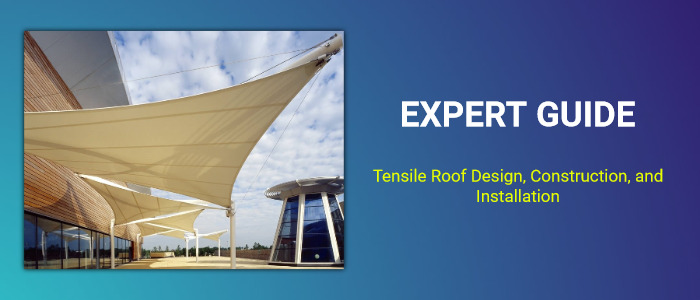June 05, 2025 By admin

A tensile roofing system is a type of roof system constructed of fabric membrane supported by cables and masts for the construction of a tensile roof structure that is minimal in design, durable, and visually appealing. These structures have become fashionable in modern construction because of their pleasing appearance, excellent load-bearing capacities, and economic viability.
The design of a tensile roof structure is a complex process that requires careful consideration of several factors, including:
Architectural Vision: The extent and quality of work to be done as relating to the structural design and outlook.
Structural Integrity: Consideration of loads produced by wind, snow, etc. on the structure with abilities to resist them.
Material Selection: The selection of fabric membranes and cables that should be appropriate for the particular situation.
Foundation Design: The various aspects of the design of the foundation on which the loads from structures will be supported.
Fabric Membrane: The original and main component in the formation of the roof external layer. It is generally constructed from high-density fabrics like PTFE or PVC material.
Cable Network: A cable structure that holds the shape of the fabric membrane roof and façade structure of a pneumatic structure.
Masts: ‘Tower-like’ steel structures that are used to support the cable network.
Foundation System: It is the foundation of the building and means the primary material or the lowest level of another structure.
Site Preparation: The preparation of the construction site will be done in this stage since this involves removing any item from the construction site and setting up temporary fences and barriers.
Foundation Construction: The foundation system is also built from, which may consist of concrete footing, piles, and other support.
Mast Erection: They are guided vertically and set down into the foundation and remain fixed there.
Cable Installation: The cable network is mounted; it connects the masts and forms the basis for the fabric membrane.
Fabric Membrane Installation: Inside the fabric membrane that is cut, sewn, and installed is a cable network.
Tensioning: To achieve the fabric membrane stress level, hydraulic jacks or any other stress-inducing devices are used.
Finishing Touches: Ready for occupancy are added fittings like lights, fans, ceilings, etc.
The construction of the tensile roof structure is a complex and complicated process that should be carried out by professionals with extensive knowledge about the tensioning of the structural fabric, rigging the cables, and more to do with structural engineering. Before construction, the building owner should hire service providers with a good background in tensile roof construction and installation.
The selection of material for a tensile roof structure plays an important role in its life cycle and appearance. The most commonly used materials include:
PTFE (Polytetrafluoroethylene) is a tough, weatherproof, self-cleaning fabric that has been popular in fabrics that need high-performance levels. It is applied to clothing, upholstery, automobiles, and other products.
PVC (Polyvinyl Chloride): Also known as shirting, this medium-weight fabric is moderately priced and very flexible in color and finish.
Stainless Steel Cables: A structural support to the fabric membrane with very high tensile strength as well as exhibiting high resistance to corrosion.
The cost of a tensile roof structure can vary widely depending on several factors, including:
Size and Complexity of the Structure: They will experience higher costs because larger structures and those that are more complicated in design are more expensive to build.
Material Selection: High-grade materials, such as PTFE, will probably cost more than PVC materials.
Labor Costs: Labor costs will, however, differ according to region and the level of skill needed in the production process.
Foundation Costs: The cost of the foundation system will depend on the nature of the soil-bearing capacity and the type of foundation.
When you focus on these aspects, it’s easier to work toward feasible costing for your tensile roof project.
Tensile roof structures offer a wide range of benefits, including:
Aesthetic Appeal: Custom and eye-catching designs.
Structural Efficiency: Inexpensive and ultralight structures of high strength and stiffness.
Cost-Effectiveness: This means that the cost of construction and maintenance of suspension structures will be extremely low.
Versatility: Designed for a variety of purposes, including sporting facilities such as stadiums and convention centers, shops, and homes.
Durability: high durability and utilization of materials that will survive various climatic conditions.
If you intend to incorporate a tensile roof structure in your future project, consult experts who will design, develop, and erect the elegant and functional structure.